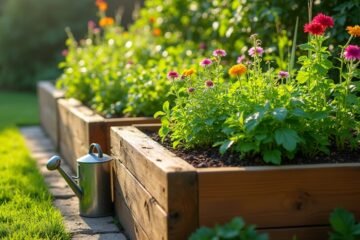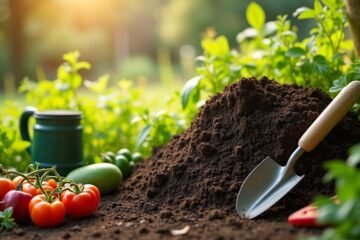When it comes to effective garden composting, picking the right bin is key! Choose a tumbler for speedy results or a stationary bin for a classic look. Mix green materials, like fruit scraps and grass clippings, with brown materials like dried leaves and cardboard. Layer them well, just like building a delicious cake! Don’t forget to aerate your pile—it’s like giving your compost a revitalizing boost! Stick around, and you’ll discover even more tips for thriving plants!
Choosing the Right Compost Bin
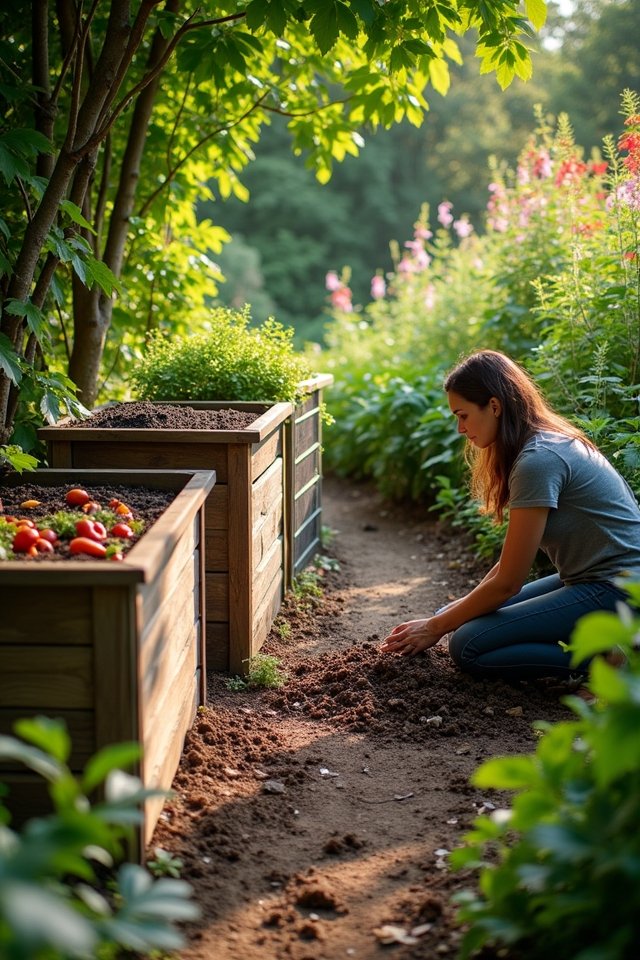
Have you ever wondered how to choose the perfect compost bin for your garden adventure? You’ve got exciting choices! Immerse yourself in compost bin types like tumblers for rapid turnover or stationary bins for a more traditional approach. Consider your compost bin location! A cozy, sunny spot accelerates decomposition, while shady corners can delay the magic. Envision the thrill of turning kitchen scraps into nutrient-rich gold! Imagine this: a sleek, modern compost tumbler spinning effortlessly, or a rustic wooden bin blending naturally into your garden. Whatever route you choose, make sure your bin is easily accessible for tossing in scraps and extracting your garden treasure. So, let’s get composting and ignite innovation in your garden! Your plants will thank you!
Understanding Green and Brown Materials
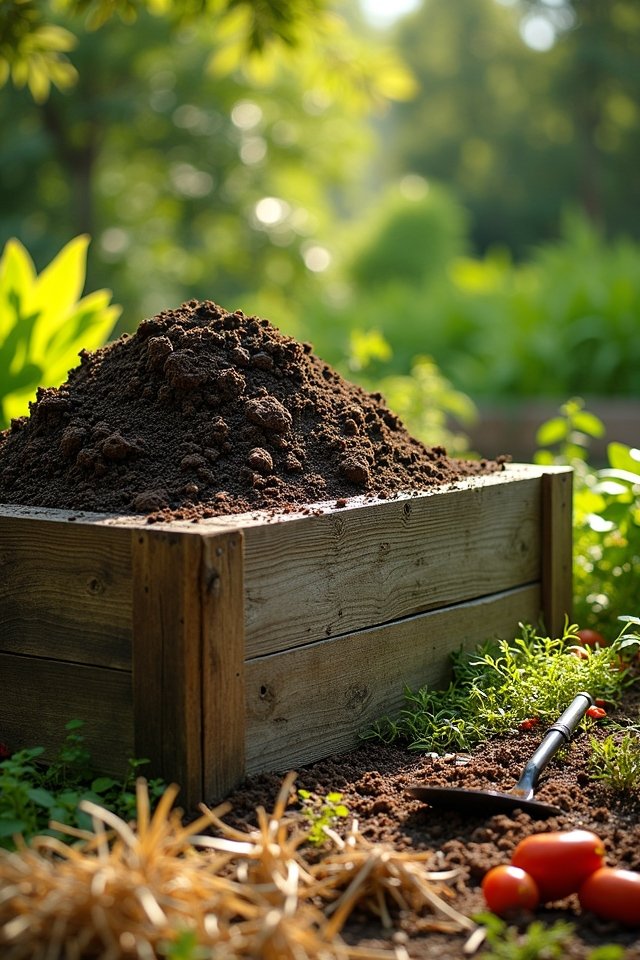
Choosing the right compost bin is just the beginning of your composting adventure! To create rich, nutrient-filled compost, you’ll need a mix of green and brown materials. Green material examples include fresh grass clippings, vibrant vegetable scraps, and lively coffee grounds—all packed with nitrogen to fuel the composting process! On the flip side, brown materials like dried leaves, cardboard, and straw offer fantastic carbon benefits, balancing out the greens and keeping your compost from becoming a soggy mess. Imagine your compost pile as a well-balanced meal, where both greens and browns play essential roles! Mixing these ingredients well not only accelerates decomposition but also gives your garden the vibrant boost it craves. Ready to explore deeper into the art of composting?
Layering Compost for Optimal Breakdown
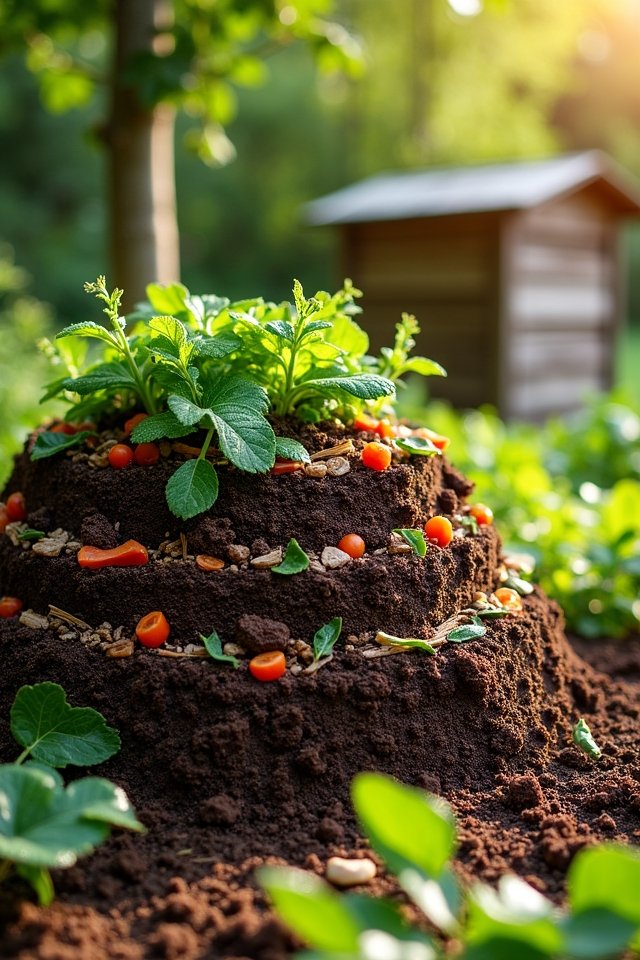
To truly make your composting experience a success, think of layering your materials like building a delicious sandwich! Start with a bottom layer of coarse browns, like twigs or straw. This helps aerate your compost, allowing air to circulate like a revitalizing breeze on a summer day! Now, add green materials in thin layers – around 1-2 inches thick works best. Think of those vibrant veggie scraps! Alternate these layers carefully; too many greens can stink up your creation. Not pleasant, right? So, balance is key! Proper compost layering encourages microbial activity that breaks down everything more efficiently. By keeping an eye on the layer thickness, you’ll be rewarded with rich, crumbly compost that’ll make your garden bloom with joy!
Utilizing Kitchen Scraps for Composting
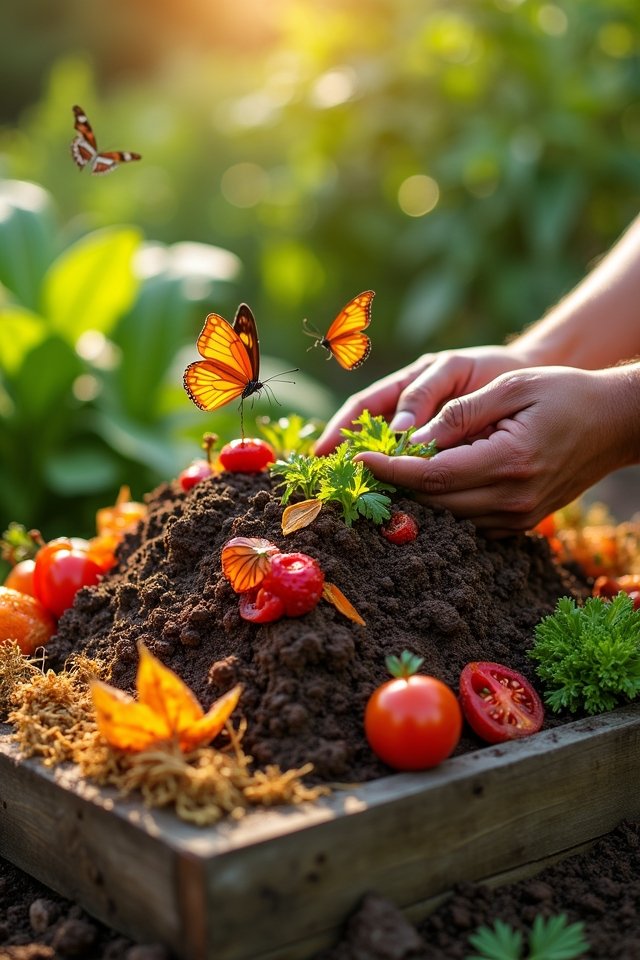
While you might not realize it, your kitchen is a treasure trove of compostable goodies just waiting to be transformed into garden gold! By utilizing your kitchen waste, you reveal incredible compost benefits that nourish your garden and reduce landfill waste.
Start collecting these fabulous scraps:
- Fruit and veggie peels
- Coffee grounds and filters
- Eggs shells
- Stale bread
Imagine tossing those forgotten vegetables or week-old bread into your compost pile instead of the trash! You’ll not only enrich your soil, but you’ll be a hero to Mother Nature! Plus, think of the delightful fragrances wafting from your thriving plants! So, plunge into those kitchen scraps, welcome creativity, and transform waste into flourishing garden magic! Who knew composting could be this exciting?
The Importance of Aeration in Composting
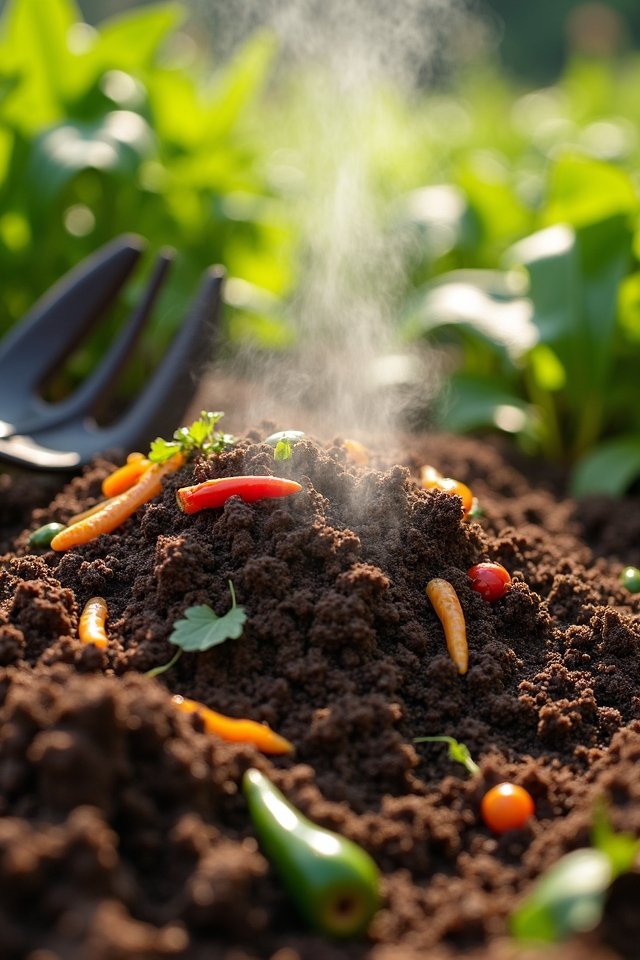
When it comes to composting, you’ve got to remember that air isn’t just for your lungs—it’s essential for your compost pile, too! Think of your compost as a living creature that thrives on attention, just like a pet! Using aeration techniques like turning your pile with a pitchfork or adding air tubes can work wonders. You’ll boost those helpful microbes that break down kitchen scraps and yard waste. Plus, good compost pile management keeps unpleasant odors at bay; nobody wants that funky smell wafting around! Don’t shy away from innovative approaches—consider using a compost aerator, which is like giving your pile the best massage of its life! So, keep it fresh and lively by ensuring your compost pile gets its much-needed oxygen!
Monitoring Moisture Levels in Your Compost
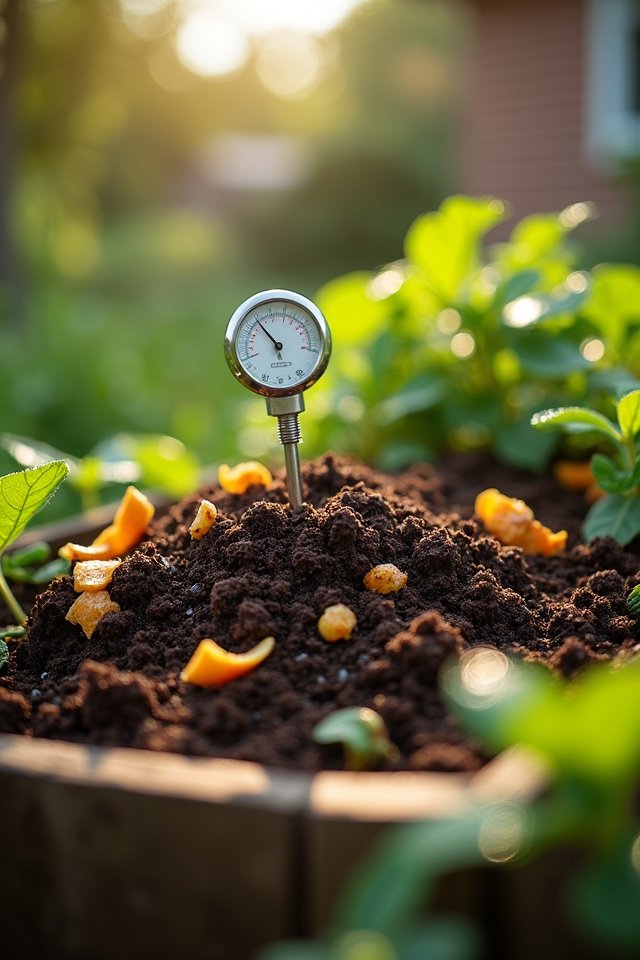
Wondering how essential moisture is for your compost? Keeping track of compost moisture isn’t just a chore; it’s an art! When it comes to making black gold, too much or too little moisture can throw a wrench in your eco-friendly masterpiece.
Here’s what you need to know about moisture measurement:
- Aim for a sponge-like texture: Feeling damp but not dripping!
- Check moisture regularly: Like a garden detective on a mission!
- Use a moisture meter: Your high-tech sidekick for precision!
- Adjust as needed: Add water or dry leaves like a culinary magician!
Mastering compost moisture makes for happy microbes. Remember, happy microbes equal a thriving compost pile!
The Role of Worms in Vermicomposting
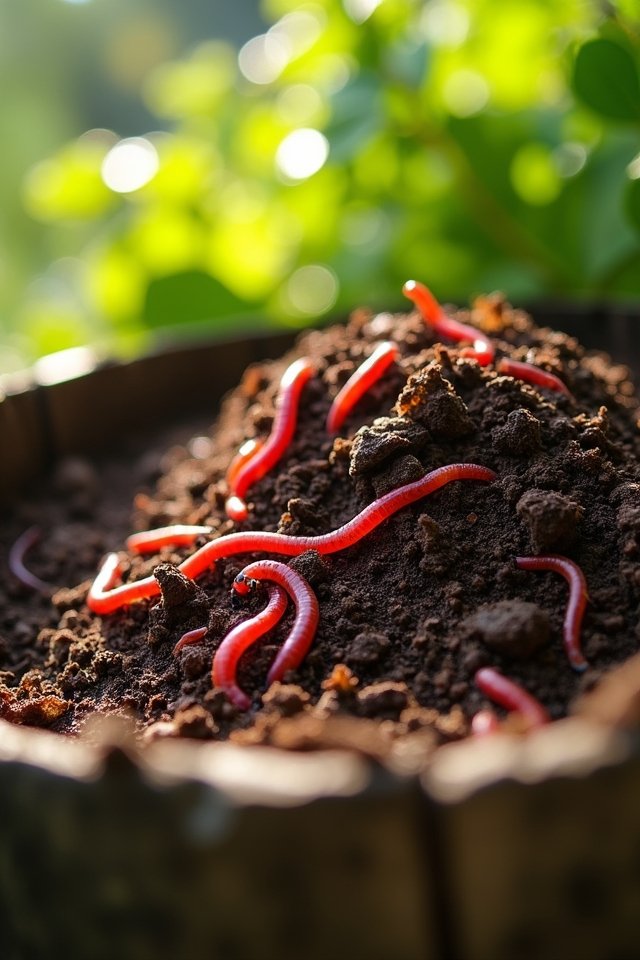
Have you ever thought of worms as nature’s little recyclers? These squiggly heroes cleverly transform your kitchen scraps and yard waste into nutrient-rich compost! By creating comfortable worm habitats, like bedding made from shredded paper or coconut coir, you’ll keep your little buddies happy and thriving. As they munch away, they’ll produce vermicast, a powerhouse of compost benefits like improved soil structure and enhanced nutrient availability. Imagine your plants flourishing with this organic treasure! Plus, they break down waste faster than you can say “earthworm!” So why not welcome these slimy sidekicks? They won’t just help your garden grow; they’ll make you feel like a genius innovator in the composting world. Worms for the win!
Hot Composting Techniques for Quick Results
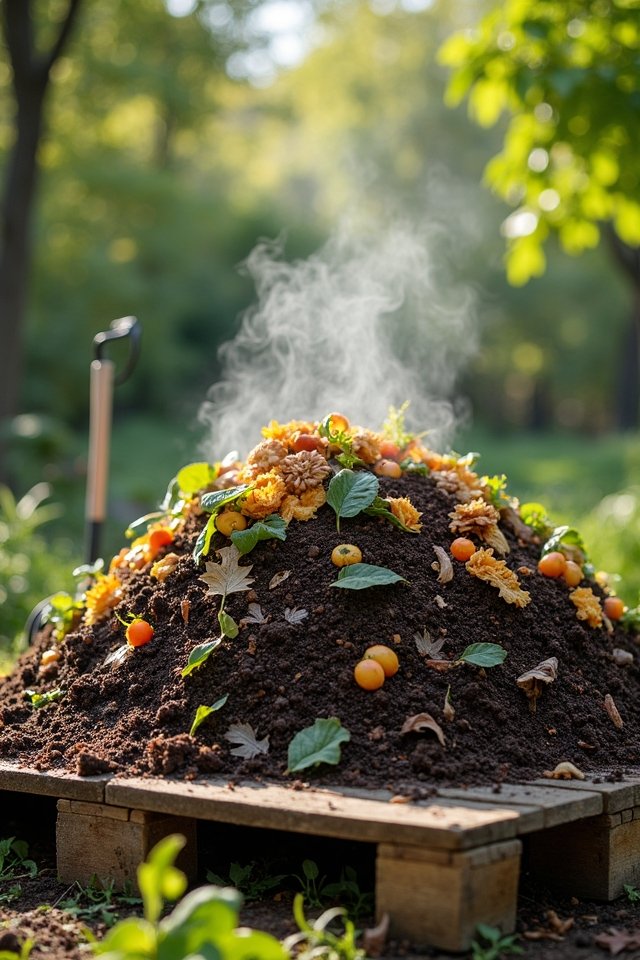
If you’re itching to whip up some compost in record time, hot composting is your go-to technique! This method heats up your pile quickly, breaking down materials like magic. To get started, remember these hot tips for successful temperature management:
- Layer wisely: Alternate carbon and nitrogen-rich materials like dry leaves and fresh grass clippings.
- Chop it up: Cut your scraps into smaller pieces for faster breakdown.
- Turn it frequently: Stir the pile every few days to keep oxygen flowing and heat levels soaring.
- Monitor the heat: Use a compost thermometer—aim for temperatures between 130°F and 160°F!
With hot composting, you’ll have rich, dark gold in no time. Your garden will thank you!
Maintaining a Balanced Carbon-Nitrogen Ratio
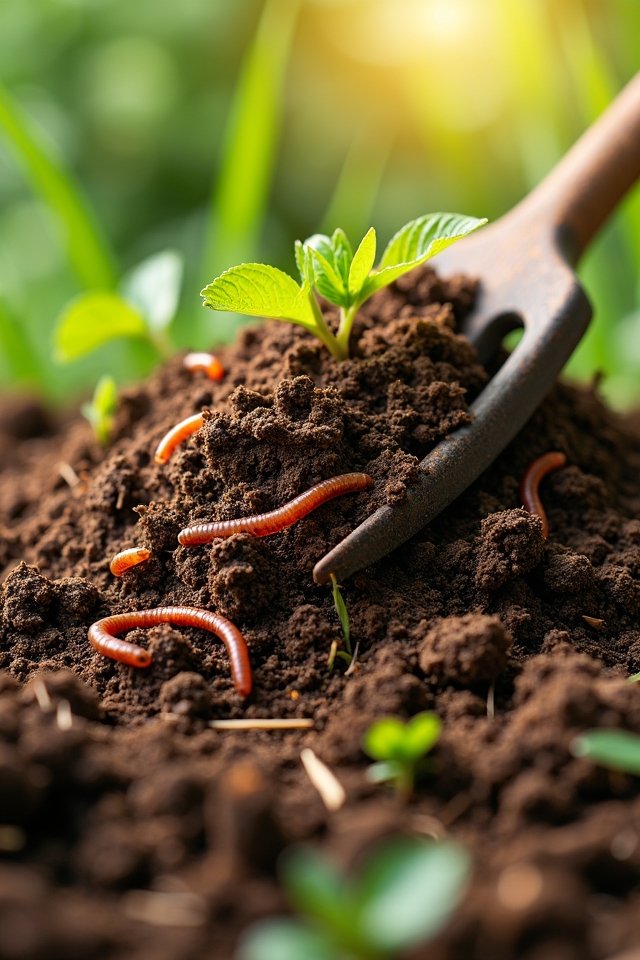
While you might be enthusiastic to toss everything into your compost pile, striking a harmonious balance between carbon and nitrogen is key to tasty, nutrient-rich compost! Think of it like cooking; without the right ingredients, your dish might flop! Carbon sources, like dried leaves and straw, provide structure, while nitrogen sources, such as kitchen scraps and fresh grass clippings, fuel the microbial action. Aim for a 30:1 ratio—imagine it as your recipe for success! If you add too many carbon sources, your compost could become a dry, lifeless pile. Too many nitrogen sources? You might face a smelly, soggy disaster! So, mix it up, layer it right, and watch your garden thrive with the delicious results of your balanced masterpiece!
Troubleshooting Common Composting Problems
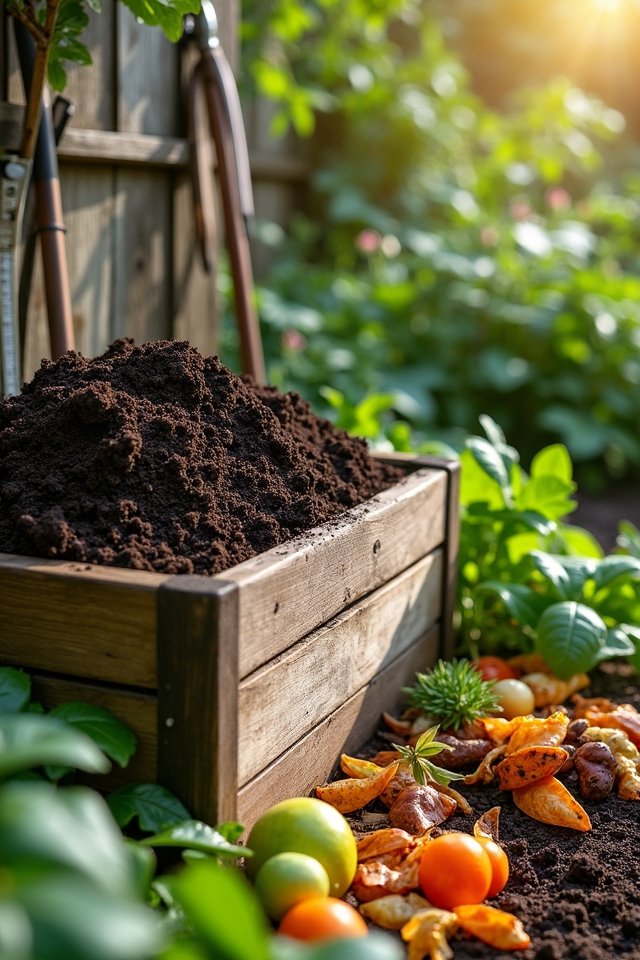
Even the most dedicated composters run into hiccups now and then! Don’t fret; troubleshooting can be an exciting challenge. If you’re dealing with unpleasant compost odor or finding pests sneaking in, you’re not alone! Here are some common issues to watch for:
- A smelly pile? Add more brown materials to balance things out!
- Attracting unwanted guests? Make sure your compost gets enough aeration; think of it like a refreshing change!
- Too wet? Layer up with dry leaves or shredded paper for a perfect mix!
- Not heating up? Turn the pile frequently to awaken the microbial magic!
With a little care, your compost can flourish, turning waste into garden gold! Happy composting!
Using Mature Compost to Enrich Your Garden
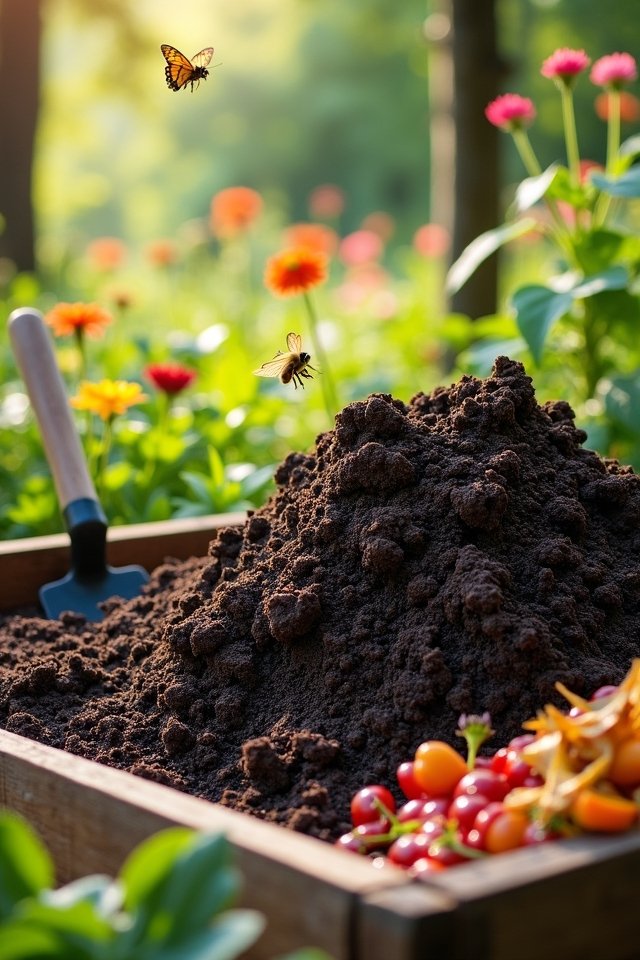
Once your compost has reached maturity, it’s like finding a treasure chest for your garden! This rich, dark gold is brimming with mature compost benefits that can transform your soil into a fertile wonderland. Why settle for mediocre plants when you can supercharge their growth? Try compost application techniques like side dressing, where you sprinkle that nutrient-packed compost directly around your plants, or mix it in for a booster shot of goodness! Imagine your plants drinking in the nutrients, reaching for the sky—it’s like magic! And guess what? Your garden will thrive, not just survive! So roll up your sleeves, grab that beautiful compost, and watch your garden blossom into a vibrant paradise! Why wait? Your plants will thank you!
Frequently Asked Questions
Can I Compost Meat and Dairy Products Safely?
You can definitely compost meat and dairy products, but you’ve got to tread carefully! Think of it as a culinary dance, where the aromas can become a bit overwhelming if you’re not precise. Meat composting invites pests, while dairy composting can lead to odors. If you’re feeling adventurous, try worm bins or hot composting methods! Just remember, balance is key—mix in those greens and browns to keep things fresh! Happy composting!
How Do I Prevent Pests in My Compost Bin?
Ah, the pesky intruders! To keep pests at bay in your compost bin, think of it as a fortress. Regular bin maintenance is key! Turn your compost weekly, mixing in pest deterrents like crushed eggshells or “secret” layers of citrus peels. Cover your bin to create a cozy retreat for microbes, not unwanted critters. And remember—no meat or dairy! With these tips, you’ll have a happy compost that’s pest-free and thriving!
What Tools Do I Need for Effective Composting?
To kick your composting game up a notch, you’ll need some nifty composting tools! A sturdy pitchfork works wonders for mixing, while a compost thermometer keeps you in the loop about those cozy temperatures. Don’t forget a moisture meter! It’s like a mini weather reporter for your bin! With these tools, you’ll master composting techniques that turn scraps into black gold, making your garden thrive like never before. Ready to dig in?
Is It Necessary to Turn My Compost Regularly?
You know, turning your compost isn’t just a chore; it’s like giving it a cozy hug! Regular compost aeration spruces up the mix, helping those tiny critters break down materials faster. When you turn it, you’ll notice a delightful earthy smell, signaling the active decomposing. Plus, you get richer nutrients for your garden! So, don’t skip this step—it’s a little effort for a huge payoff! Who wouldn’t want super compost?
How Long Does It Take for Compost to Mature?
Did you know compost can mature in as little as three weeks? That’s faster than a Netflix binge! The compost maturation timeline varies, influenced by factors like temperature and moisture. So, if you toss in fresh kitchen scraps with dried leaves, you’ll create a feast for those hungry microbes! Remember, the hotter the pile, the quicker the magic happens! Isn’t it exciting to transform waste into black gold? Your garden will love it!

